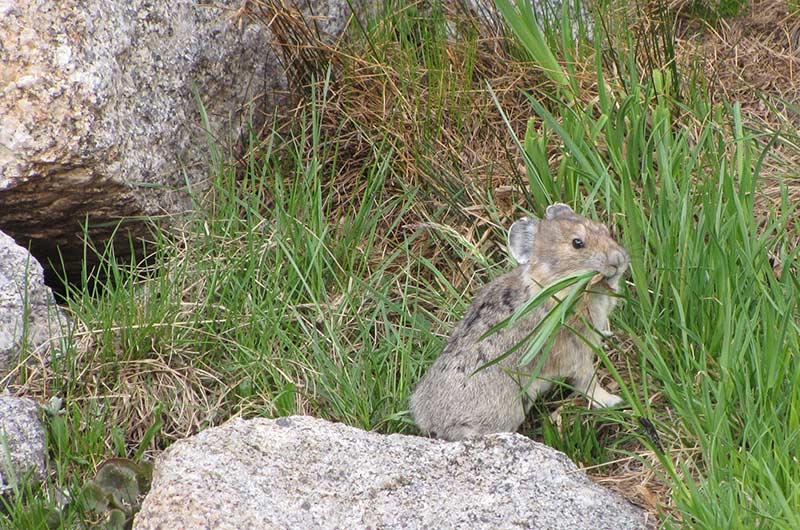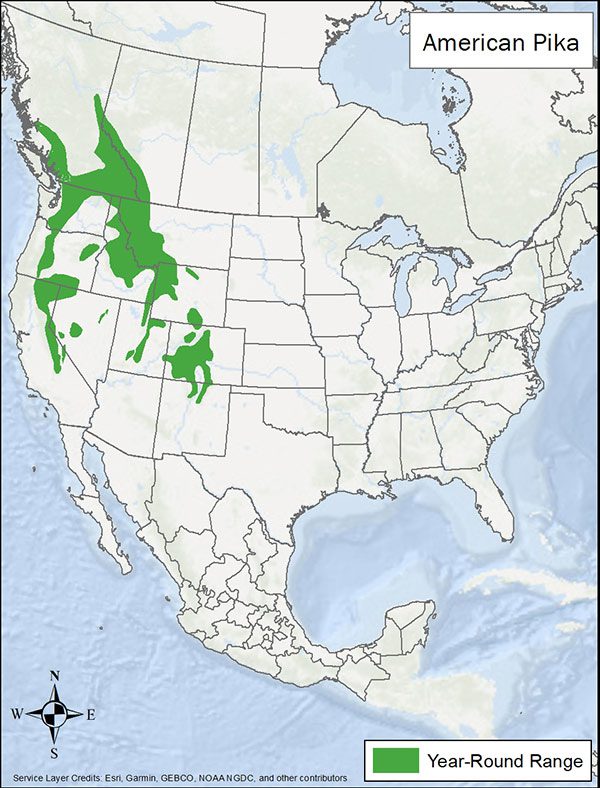LandPKS Learning
Habitat Hub

American Pika
American pika are very sensitive to temperatures and can die if exposed for brief periods to temperatures greater than 77.9o F/ 25.5o C. They rely on a moderate snowpack to insulate them from extreme cold. Pikas have high energetic demands as they do not hibernate. Therefore they are considered an indicator species for climate change especially temperature extremes and changes in snow.
Ochotona princeps
Identification
American pika is a small, round mammal in the rabbit family, 6-8 in/15-10 cm with no visible tail. Fur color is gray to tannish brown. The pika has large round ears. They have sharp curved claws and padded toes making it easy to climb in and among rocks.
Observation Tips
The American pika live in the mountains of western North America across more than 40 mountain ranges. They are generalist herbivores that gather and cache food in the summer for winter consumption. They can often be seen gathering grasses and forbs in summer near rocky dens. Pikas live in colonies and call out a warning “eek” when they sense a predator is near. Therefore, they are often heard before they are seen. Pikas occur in many high elevation National Parks and National Forests.
Interesting Fact
American pika are very sensitive to temperatures and can die if exposed for brief periods to temperatures greater than 77.9o F/ 25.5o C. They rely on a moderate snowpack to insulate them from extreme cold. Pikas have high energetic demands as they do not hibernate. Therefore they are considered an indicator species for climate change especially temperature extremes and changes in snow.
Ideal Habitat
American pikas live in rocky habitats in mountains where alpine and subalpine meadows meet talus slopes or boulder fields. They can be found in lower elevations in rocky areas within forests. Pika primarily eat grasses, sedges, and forbs gathered from alpine and subalpine meadows. They are more abundant when meadows have >10% herbaceous cover adjacent to rocky areas. In late summer and fall they harvest and store food for winter consumption. Pika will lay out their harvest in the sun to dry before storing them in their dens. Food is stored in haystacks in the den. In winter some foraging may occur using snow tunnels.

Range map provided by International Union for Conservation of Nature
Management Activities that Benefit Species – Best Management Practices (BMPs)
Restoration of degraded alpine and subalpine meadows especially areas adjacent to talus slopes or boulder fields, will benefit pika. As American pika is thought to be sensitive to climate change, several states are interested in knowing when they are seen. For example, Washington has an app so that people can easily document when pika are seen. Colorado’s pika partners has established a long-term monitoring project for pika.
Management Activities to Avoid
Avoid damaging or destroying alpine and subalpine meadows through heavy or concentrated livestock grazing or offroad vehicle use near rocky slopes, boulder fields and talus slopes.
Other Species that Benefit from Similar Habitat Management
Management for American pika benefits predators of pika including weasels, coyotes, and hawks. Pika also are often used as an indicator of the health of alpine areas.
Download
Download the American Pika Factsheet
Descarga la ficha de pica americana
Other Resources
International Union for Conservation of Nature (IUCN). 2014. The IUCN Red List of Threatened Species. Version 2021-1 American pika
Montana Field Guide. Pika
NatureServe. 2021. NatureServe Explorer: An online encyclopedia of life [web application]. Version 7.1. NatureServe, Arlington, Virginia. American pika
NPS. Pikas
USFWS. American pika
USFS Research. American pika tolerate climate change better than expected.
Washington Department of Fish and Wildlife. American pika
Photo credit: Chris Kennedy, USFWS/Flickr
Mobile App | Data Portal | Knowledge Hub | Habitat Hub | Learning Collections | Blog | About | Contact | Support



